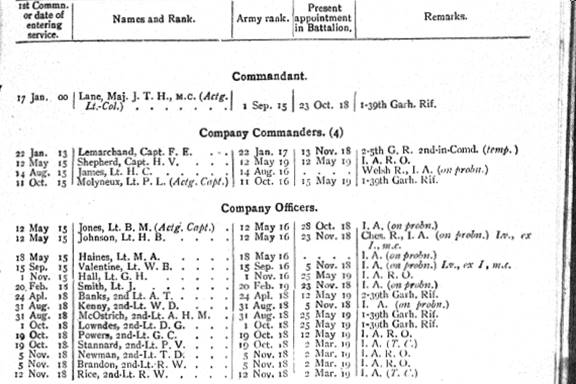This article about the 4th Battalion, 39th Garhwal Rifles and will help you to research the Battalion and those who served with it during the First World War. I have written separate articles for the 1st, 2nd and 3rd Battalions and a series of guides to help you research soldiers who served in the Indian Army during World War One. To view the guides, click on the links below:
- 3rd Battalion 39th Garhwal Rifles
- Guides to Researching Soldiers who Served in the Indian Army in WW1
The 4th Battalion, 39th Garhwal Rifles in the First World War
Lineage: The 4th Battalion 39th Garhwal Rifles was formed at Dehra Dun (Dehradun, Uttarakhand, India) on 28 October 1918 and became 4th Battalion 39th Royal Garhwal Rifles in 1921 and the 10 Battalion 18 Royal Garhwal Rifles, a training battalion, in 1922. For a history of the Regiment’s lineage see my page on the 1st Battalion 39th Garhwal Rifles.
Class Composition of Battalion in April 1919: 4 Companies of Garhwalis. July 1921: 3 Companies of Garhwalis.
The 4th Battalion 39th Garhwal Rifles was one of two new battalions raised by the 39th Garhwal Rifles during the First World War. The 4th Battalion was formed at Dehra Dun (Dehradun, Uttarakhand, India) on 28 October 1918. The Battalion’s first commanding officer was Acting Lieutenant-Colonel Joscelyn Theodore Hosburgh Lane MC who was appointed from the 1st Battalion on 23 October 1918.
The Battalion was stationed at Ambala (Haryana, India) when it was mobilised on the outbreak of the Third Anglo-Afghan War in May 1919. The Battalion joined the North West Frontier Force on 11 May 1919 and there is a war diary covering events between April and July 1919. I have transcribed some of the entries from the war diary below. The 4th Battalion 39th Garhwal Rifles served with the 60th Infantry Brigade, Kohat-Kurram Force during the war. The Battalion continued to serve on the North West Frontier into 1920 before it returned to Lansdowne (Uttarakhand, India) where its Depot was located. In 1922, the Battalion became the 10th Battalion, 18th Royal Garhwal Rifles, a training battalion.
The extract below is taken from the July 1919 Indian Army List and records the British officers serving with the Battalion. Many of the British officers hold temporary commissions (TC), are on probation (on. probn.) or from the Indian Army Reserve of Officers (IARO).
War Diary of the 4th Battalion, 39th Garhwal Rifles
There is only one war diary for the Battalion which as of February 2017 hasn’t been digitized and can only be viewed at the National Archives. I have a copy of the war diary and have transcribed some of the entries below.
- Date: 15 April – 31 July 1919
- 60th Infantry Brigade, Kohat-Kurram Force
- Reference: WO 95/5392
- Notes: This is the only war diary for the 4th Battalion, 39th Garhwal Rifles and it is short and not very detailed. The majority of days have no entry and no names appear.
Further Sources for the 4th Battalion, 39th Garhwal Rifles
For information concerning British and Indian officers who served with the 4th Battalion 39th Garhwal Rifles the Indian Army List can be consulted. There are two confidential reports for the Battalion, however, both only concern its Depot. These reports also contain the reports of the British officers serving with the Battalion’s Depot:
- Confidential review reports on Indian Army units, depots, British officers, etc. for 1919-1920 IOR/L/MIL/7/17031.
- Confidential review reports on Indian Army units, depots, British officers, etc. for 1920-1921: IOR/L/MIL/7/17032.
Extracts from War Diary of the 4th Battalion, 39th Garhwal Rifles
15 April – 31 July 1919, Kohat-Kurram Force, WO 95/5392
15 April 1919 – Left Dehra Dun. Strength 450 at 2.30 am. Only 2 hours notice without baggage. Weather fine and very hot. Arrived at Amballa, detailed as part of 46th Mobile Brigade for internal security.
15 May 1919 – Draft 200 strong arrived from depot 1st Battalion 39th Garhwal Rifles.
19 May 1919 – Arrived at Kohat armed with short high velocity rifles. Started our own British officers mess.
25 May 1919 – Entrained for Thal 400 strong, detachment of 256 (D Company) remained at Kohat. Detrainied at Thal 11 pm. Bivouacked for night.
26 May 1919 – Took over camp and outpost picquets and started sangaring.
27 May 1919 – Attack by enemy on Thal village, attack repulsed. Fort shelled.
28 May 1919 – Thal invested, railway and road cut, fort and camp shelled.
30 May 1919 – Enemy shelled camp and fort. Bhoosa [straw] stacks and ration dump and petrol dump set alight. One casualty in Battalion. Enemy attack by night on Picquet Hill and water picquet did not mature. Troops put on half rations.
02 June 1919 – Thal – South of camp. Battalion took over picquets from 1st Battalion 151st Sikhs at night. Weather dry and very hot…. Aeroplanes bombed Biland Khel and machine gunned a collection of 400 of the enemy. In the afternoon we heavily shelled Biland Khel. Supply trains ran through to Thal from Kohat. Brigadier General Dyer assumed command of Thal.
04 June 1919 – Attempt to destroy the important village of Biland Khel by 3rd Battalion 9th Gurkha Rifles supported by A and C Companies 4th Battalion 39th Garhwal Rifles. Destruction was not carried out as village river was unfordable.
30 June 1919 – Ceremonial parade to celebrate signing of peace. 101 rounds fired by Battery. March past. Weather fine and hot.

